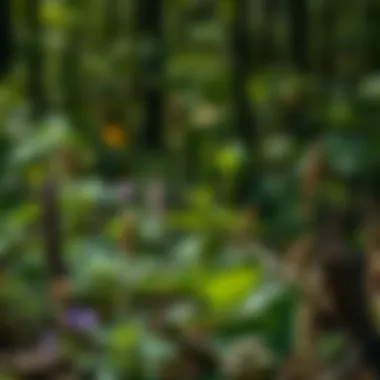Medicinal Herbalists and Their Role in Forest Stewardship


Intro
The intricate relationship between herbalism and environmental stewardship is often underappreciated. Medicinal herbalists, with their deep-rooted wisdom, stand at the confluence of traditional practices and contemporary conservation challenges. Their role extends beyond merely collecting plants; it's about fostering a holistic approach that intertwines the well-being of communities with the health of forests. By understanding the ecological intricacies of medicinal plants, these practitioners can significantly contribute to forest stewardship. This discussion delves into crucial aspects, revealing how the expertise of herbalists can influence sustainable woodland management while preserving biodiversity and educating communities.
Forest Ecology and Biodiversity
Importance of Forest Ecosystems
Forest ecosystems serve as the lungs of our planet, playing an indispensable part in maintaining ecological balance. They provide crucial habitat for a myriad of species, regulate climate, and stabilize soil. However, with increasing urbanization and industrial activities, these vital ecosystems face unprecedented threats. Here, medicinal herbalists can make significant strides in conservation through their holistic understanding of forest dynamics.
Medicinal herbalists have traditionally relied on a diverse array of plants. They recognize that every tree, flower, and shrub is a potential resource, not just for medicine but for the entire ecosystem. By promoting sustainable harvesting of these plants, they address exploitation while increasing community awareness about the importance of preserving native flora.
"Preserving our forests isn't just about saving trees; it's about protecting the intricate web of life that depends on them."
Flora and Fauna in Woodlands
Woodlands are rich tapestry of life. Each species, whether plant or animal, plays a critical role in maintaining the balance of their habitat. Medicinal herbalists contribute to this tapestry by emphasizing the importance of diverse plant species. Many plants possess unique medicinal properties, and understanding their ecology also sheds light on their interactions within the ecosystem.
Certain plants, like Echinacea purpurea or Ginseng, not only hold significant medicinal value but also support local wildlife by providing shelter and food. Additionally, the symbiotic relationships between various flora and fauna further emphasize the need for preserving these environments. By employing practices that respect and promote biodiversity, herbalists not only secure their resources but also contribute to broader environmental health.
Sustainable Forestry Practices
Techniques for Responsible Management
Sustainable forestry practices focus on managing forest resources that meet the needs of the present while ensuring that future generations can also benefit. Medicinal herbalists often advocate for techniques such as selective logging, which minimizes environmental impacts and promotes forest regeneration. Harvesting practices that consider seasonal changes and ecological cycles can ensure both plant health and continuity of supply.
Understanding soil health, water management, and the maintenance of wildlife corridors are also essential to sustainable practices. Medicinal herbalists can engage communities by sharing knowledge about these systems and encouraging local stewardship of the forests. This is crucial, as local participation is needed to effectively implement sustainable practices in forest management.
Certification Schemes and Standards
Different certification schemes, such as the Forest Stewardship Council (FSC) and the Programme for the Endorsement of Forest Certification (PEFC), promote sustainable forest management. These certifications provide guidelines that ensure harvesting practices are environmentally responsible.
Medicinal herbalists can contribute by using certified products in their practices, thus promoting a market for sustainably sourced herbal ingredients. In doing so, they not only support viable local economies but also raise awareness of the importance of sustainable forestry among consumers. Their involvement can lead to a more informed community that values and actively participates in sustainable practices.
Community Engagement and Stewardship
Role of Local Communities
Community involvement is a cornerstone of successful forest stewardship. Medicine herbalists often serve as a bridge between traditional knowledge and modern conservation efforts. They can foster a sense of ownership within communities regarding their natural resources. Engaging local residents in preserving and managing forest resources enhances both biodiversity and community resilience.
Education plays an essential role here. Informative workshops, guided herb walks, and collaborative planting events not only impart knowledge but also empower community members, weaving their history and traditions into the fabric of forest stewardship.
Volunteer Opportunities for Engagement
Medicinal herbalists can capitalize on volunteer opportunities to enhance community engagement and bolster conservation efforts. By organizing community events focused on herb gardening, reforestation, and habitat restoration, they create spaces for people to connect with nature and each other.
Such initiatives encourage individuals to take active roles in local stewardship, fostering communities that prioritize environmental health. In these settings, herbalists can lend their expertise on sustainable practices, ensuring that community efforts align with ecological needs.
In summation, the role of medicinal herbalists in promoting forest stewardship reflects a deep understanding of the interconnectedness of ecological health and community well-being. By leveraging traditional knowledge and sustainable practices, they can contribute significantly to the preservation of biodiversity and the cultivation of responsible stewardship, ensuring vibrant forests for generations to come.
Understanding Medicinal Herbalism
Medicinal herbalism is an ancient practice that combines the use of plants for therapeutic purposes with an understanding of their ecological context. This section aims to unravel the nuances inherent in herbalism befitting forest stewardship, emphasizing its significance for both health and environmental conservation. By exploring the foundations of medicinal herbalism, readers will appreciate its relevance in today’s world, particularly concerning sustainability and biodiversity.
Definition and Scope
Medicinal herbalism may be defined as the art and science of using plants for medicinal purposes. This umbrella term encompasses a range of practices, from traditional methods of preparing herbal remedies to modern applications in alternative medicine. Herbalists often rely on local flora, gathering a deep dialect with their environments. In fact, the scope of this discipline stretches across various cultures, each adapting its knowledge to suit the specific species and ecosystems they inhabit.
In simple terms, herbalism is about harnessing nature’s pharmacy to aid health and healing. However, understanding this practice goes beyond just knowing what herbs to use. It demands a thorough understanding of the plant's environment, growth patterns, and the ethical considerations surrounding their harvesting. This intersection of herbal practices and environmental awareness sets a foundation for effective forest stewardship.
Historical Context


Medicinal herbalism isn’t any newfangled trend; its roots dig deep into human history. Ancient civilizations like the Egyptians and Sumerians meticulously documented plant properties, while texts from Traditional Chinese Medicine offer insights into herbal uses spanning thousands of years. In many native cultures, knowledge about medicinal plants was sacred and passed down through generations.
Emerging from this lineage, modern herbalism is often seen as a revival of these age-old traditions. As people began to recognize the limitations of synthetic drugs, a renewed interest in herbal remedies surged in the late 20th century. Yet, this revival is not simply nostalgic; it marks an evolution influenced by ongoing scientific research into phytonutrients and the holistic benefits of plants.
Philosophical Foundations
At the heart of medicinal herbalism lie philosophical underpinnings that underscore the relationship between humans and the natural world. Integral to this practice is the belief in interconnectedness – the idea that the health of an individual is tied directly to the health of the ecosystem. Herbalists often advocate for a balance where cultivation, harvesting, and reverence for nature coalesce.
Moreover, the philosophies of herbalism invite practitioners to contemplate the ethical dimensions of their work. This encompasses responsibility for sourcing plants, ensuring that harvesting does not damage ecosystems, and working to protect biodiversity.
"In this dance with nature, herbalists become stewards of the ecosystems they draw from, ensuring sustainability for generations to come."
In summary, medicinal herbalism serves as a bridge connecting the health of individuals with the vitality of the forests from which many herbs derive. By delving into its definitions, historical significance, and philosophical tenets, we can begin to understand how herbalists contribute meaningfully to forest stewardship.
The Medicinal Herbalist's Toolkit
The toolkit of a medicinal herbalist encompasses far more than just the herbs they utilize. It is a comprehensive system that involves skills, knowledge, and ethical practices. The importance of this toolkit in promoting forest stewardship cannot be overstated. Each element contributes to a broader understanding of how herbalism supports ecological balance and sustainability.
Identifying Medicinal Plants
This is the fundamental skill for any herbalist. Identifying medicinal plants involves recognizing their unique characteristics, such as leaf shape, flower color, and the way they grow in their environments. Knowledge of local ecosystems is crucial here, as native plants often have developed complex relationships with the local fauna. The ability to identify plants not only allows for the effective use of their medicinal properties but also plays a pivotal role in conservation efforts. Herbalists can pinpoint endangered species and work towards their protection, ensuring these plants remain available for future generations.
Harvesting Practices
Ethical harvesting goes hand-in-hand with being a responsible herbalist. Here's how each component plays a vital role:
Ethical Considerations
Ethical considerations in harvesting refer to the practices that ensure plants are gathered without endangering their populations or the broader ecosystem. Herbalists prioritize methods that allow plants to thrive. This includes taking only what is necessary and leaving sufficient plants behind to continue growing and reproducing.
- Key characteristic: This approach fosters long-term sustainability.
- Beneficial choice: It reinforces the idea that herbalists are stewards of the earth, not just consumers of its bounty.
- Unique feature: Ethical harvesting often requires intense local knowledge and deep respect for the land, allowing herbalists to create lasting relationships with their environments. Thus, embracing ethical considerations supports both personal growth and the health of the ecosystem.
Sustainable Techniques
Sustainable techniques refer to practices that not only minimize harm but also actively contribute to the regeneration of plant populations. This can involve selective harvesting, rotational gathering, and even cultivating medicinal plants in managed landscapes.
- Key characteristic: Emphasizes the interconnectedness of all living things.
- Beneficial choice: Using sustainable methods ensures that the herbalist's work does not negatively impact the environment.
- Unique feature: These techniques can lead to increased biodiversity within managed forest areas, benefiting other flora and fauna and enhancing ecosystem resilience.
Preparation Methods
Preparation methods are equally vital for extracting the medicinal properties of plants. The distinction between methods often lies in the means of extraction and application.
Tinctures and Extracts
Tinctures and extracts are concentrated forms of herbal medicine, made by soaking plant material in alcohol or glycerin. This method captures the plant's essence, making it potent and easier to use.
- Key characteristic: They tend to have a long shelf-life, which is practical for both herbalists and consumers.
- Beneficial choice: Tinctures are easily absorbed by the body, which makes them popular among those seeking effective remedies.
- Unique feature: While they're incredibly useful, tinctures require careful preparation to ensure the right balance between potency and safety. As such, herbalists should always consider the ethics of sourcing their ingredients, ensuring they maintain the integrity of their product.
Infusions and Decoctions
Infusions and decoctions are simpler preparations typically made using water. Infusions involve steeping leaves and flowers in hot water, while decoctions often use harder plant parts like roots.
- Key characteristic: These methods allow a wide array of plants to be utilized, empowering herbalists to incorporate locally sourced plants into their practice.
- Beneficial choice: They can easily be made at home, promoting self-sufficiency and personal responsibility when it comes to health.
- Unique feature: Infusions and decoctions are more accessible than tinctures, making them suitable for a broader audience. However, they may not carry the same potency, requiring users to have realistic expectations regarding the effects.
The Intersection of Herbalism and Ecology
Understanding how herbalism intertwines with ecological wellness is not just fascinating; it's essential. Medicinal herbalists play a critical role in the realm of forest stewardship by promoting practices that safeguard environmental health while supporting the use of medicinal plants. This intersection merges age-old wisdom with contemporary ecological principles, establishing a framework through which both disciplines can thrive. It encapsulates the idea that taking care of the earth supports not just the plants that grow upon it, but also the communities that rely on these resources.
Biodiversity Preservation
At the heart of this intersection is biodiversity preservation, a tenet that underscores the necessity for variety in plant and animal species within an ecosystem. The role of medicinal herbalists in this context is pivotal. They do not only harvest plants for their medicinal properties but also advocate for their conservation. By promoting the understanding of local flora, herbalists foster appreciation for native species and their ecological roles. This knowledge aids in combating the headwinds of extinction that many medicinal plants currently face, often due to habitat destruction and over-exploitation.
Moreover, herbalists often work within communities to raise awareness about the importance of local plants and their ecological contributions. Collaborative initiatives often unfold, where the community gets involved in planting native species, thereby reinforcing local ecosystems and resisting the encroachment of invasive plants. This embedding of biodiversity in community practices forms a solid foundation for a sustainable future.


Ecosystem Services Provided by Medicinal Plants
Soil Health
The health of soil is a silent yet profound contributor to ecological wellbeing. Medicinal plants play a fundamental role in improving soil health by preventing erosion, enhancing nutrient content, and promoting soil microbiome diversity. Many of these plants—such as comfrey or nettle—are known to have deep root systems that penetrate the ground, aerating and enriching it. This is an aspect that herbalists relish because, at the crux of their craft, lies an understanding of how vital soil integrity is for successful plant growth. By cultivating medicinal plants, herbalists not only serve their needs but also contribute to maintaining soil vitality, which in turn supports broader environmental stability.
One unique feature of plants that support soil health is their ability to form mycorrhizal relationships. This mutually beneficial association between fungi and plant roots enhances nutrient absorption. This interaction isn't just beneficial; it’s essential for preserving soil health long-term, showcasing the integral relationship between herbalism and ecological health.
Habitat Creation
Habitat creation is another significant aspect where herbalism contributes to the ecological landscape. Medicinal plants often serve as a sanctuary for a multitude of species, providing food and shelter, which creates a web of life that promotes a thriving ecosystem. By planting native medicinal plants, herbalists effectively build habitat corridors that enable wildlife to flourish. This recognition of the interconnectedness of all things in nature allows herbalists to act as stewards who not only tend to individual plants but also nurture larger ecological systems.
This kind of habitat initiative is also a way of engaging more people in conservation efforts. When communities see the benefits—like increased bird populations or enhanced insect life—they become more inclined to participate in local stewardship projects. Creating habitats for both medicinal plants and local fauna can foster a sense of responsibility toward the environment, stitching healthy practices into the fabric of community life.
Herbalism as a Conservation Tool
The role of herbalism, particularly in the context of conservation, cannot be overstated. Medicinal herbalists are often the bridge between people and plants, nurturing relationships that deepen awareness of traditional practices and their relevance today. They help demystify the healing power of plants while promoting responsible use that honors their existence. Herbalists advocate for ethical harvesting and encourage sustainable sourcing, which not only conserves the plants themselves but augments a community's connection to the land.
In many ways, herbalism becomes a conservation tool through education—informing the public about the delicate nuances of plant ecosystems, teaching about the importance of maintaining indigenous flora, and inspiring grassroots activism through community involvement. As herbalists work to integrate these principles into daily life, they also create a sustainable model for herbal medicine that respects, rather than exploits, the earth's resources.
In essence, the intersection of herbalism and ecology is about symbiosis; it's a mutualistic relationship that benefits people, plants, and the planet alike.
Cultural Significance of Medicinal Plants
The narrative of medicinal plants transcends the mere act of healing; it is interwoven with the identities, beliefs, and practices of countless cultures. Understanding the cultural significance of these plants not only enriches the field of medicinal herbalism but also underscores the responsibility of herbalists in promoting forest stewardship. The cultivation and management of medicinal plants involve respecting traditional systems of knowledge that have been passed down through generations, connecting people to their land and resources in profound ways.
Traditional Knowledge Systems
Indigenous and local communities often possess intricate systems of knowledge concerning the use of medicinal plants. This traditional knowledge is built on years of observation and interaction with the environment, shaping their practices around sustainability and reverence for nature.
For instance, many tribal communities understand the migratory patterns of plants, knowing when to harvest without over-exploiting them. This wisdom ensures a balance between human needs and ecological health, embodying a holistic view that modern science often calls for but struggles to fully achieve. The challenge lies in recognizing and legitimizing these systems in contemporary legislation and conservation efforts. Meanwhile, the embrace of these ancient practices by herbalists promotes a narrative that respects the deep-rooted cultural significance of plants while advocating for ecological sustainability.
Modern Interpretations
The journey of medicinal plants does not stop with their traditional uses; it evolves through modern interpretations that often incorporate these historical insights into today’s context. Herbs long valued by indigenous cultures now find their way into the broader health and wellness sectors, redefined by contemporary users who seek natural alternatives to conventional medicine.
Contemporary Uses
In today’s health-conscious world, the interest in contemporary uses of medicinal plants is escalating. People are increasingly turning to herbal remedies for everyday ailments, prioritizing natural options over pharmaceuticals whenever possible. This shift reflects a growing desire for holistic lifestyles that align with personal and environmental health.
- Herbal Teas: The infusion of herbs like chamomile or peppermint serves not only as a comforting drink but also promotes relaxation or digestion.
- Essential Oils: Many are integrating oils extracted from plants like lavender or eucalyptus into aromatherapy, harnessing their calming effects.
The unique feature of these contemporary practices lies in their ability to bridge the gap between ancient wisdom and modern wellness trends. The advantage here is clear: these practices not only support health but also foster a greater awareness of plant significance, enhancing forest stewardship as individuals recognize the need to protect biodiversity.
Integration into Healthcare
The integration of medicinal plants into healthcare systems is another avenue of cultural significance that merits attention. Herbalists are increasingly working alongside conventional medical practitioners to harmonize the strengths of both worlds. This partnership can lead to more holistic treatment plans that address both the physical and emotional dimensions of health.
Consider, for instance, the inclusion of herbs like ginger in treatment protocols for nausea or inflammation. Such integrations highlight a key characteristic of modern healthcare; they embrace patient preferences for natural remedies, thus respecting cultural traditions while providing effective care.
The unique feature of this integration is its potential to diversify treatment options, offering patients a choice that resonates with their values and beliefs. However, challenges remain, including the need for rigorous research to ensure safety and efficacy, which makes this a constantly evolving field. Balancing tradition with modern scientific validation will be pivotal in solidifying the role of medicinal plants in mainstream healthcare.
"The beauty of medicinal plants lies not only in their healing properties but also in their deep connections to cultural identities and ecological stewardship."
Challenges Facing Medicinal Herbalists
The landscape for medicinal herbalists isn't all smooth sailing. Various challenges confront these practitioners, affecting their ability to contribute effectively to forest stewardship. From navigating the complexities of legal frameworks to facing the dire realities of environmental threats, these practitioners must tread carefully to maintain their vital role in conservation. Addressing such challenges not only elevates their craft but also highlights the broader implications for biodiversity and sustainability in forest ecosystems.
Legal and Regulatory Issues
Medicinal herbalists often find themselves entangled in a web of legal and regulatory hurdles. Government regulations regarding the collection, use, and sale of medicinal plants can be stringent and confusing. For example, some herbs are protected under conservation laws, requiring permits for any form of harvesting. Not knowing these laws can lead to unintentional violations which could impact both their livelihoods and the ecosystems they aim to support.


Moreover, differing regulations across regions can add to the complexity, making it hard for herbalists to operate across state or national lines. This inconsistency can stifle innovation and collaboration. However, understanding these legal landscapes can empower herbalists to advocate for more supportive policies that balance conservation efforts with the need for traditional practices.
Environmental Threats
The environmental backdrop is rapidly changing, presenting significant challenges for medicinal herbalists. Two prominent threats include habitat loss and invasive species, both of which have far-reaching consequences for not just the herbalists themselves, but also the ecosystems they rely on.
Habitat Loss
Habitat loss is a pressing concern that affects a variety of plants, including those used for medicinal purposes. As forests are cleared for agriculture, urban development, or mining, the flora takes a serious hit, leading to a significant decline in biodiversity. For the medicinal herbalist, the availability of local, native plants diminishes, pushing them to either search farther afield or rely on cultivated varieties worse suited to their craft. A key characteristic here is that as fewer natural resources are available, the integrity of herbal practices may be at risk.
Moreover, habitat loss can lead to the extinction of traditional knowledge about native plants. When these landscapes change drastically, the connection between herbalists and their natural resources weakens, jeopardizing cultural and ecological varieties that have stood the test of time.
Invasive Species
Invasive species are another significant hurdle. They often outcompete native plants, aggressively taking over ecosystems and disrupting the delicate balance of the forest. The introduction of foreign flora can lead to a decline in the specific medicinal plants that herbalists rely on. Consider the case of garlic mustard, an invasive herb that spreads like wildfire, outcompeting native wildflowers. This can gradually erase the ecological niche that native herbs occupied, effectively shutting herbalists out of their traditional resources.
The unique feature of invasive species is that their management often requires significant resources and strategic planning. This can drain local efforts towards sustainable forest stewardship as herbalists must balance their workload between utilizing native plants and contending with these unwelcome visitors.
Market Dynamics
The commercial landscape surrounding herbal products is ever-changing and can create both opportunities and challenges for medicinal herbalists. The growing public interest in natural remedies has spurred the market, but it also brings complexities that are hard to navigate.
Commercialization of Herbal Products
As herbal remedies gain popularity, the commercial potential is often appealing, leading herbalists to consider turning their practices into profitable ventures. However, commercialization carries the risk of compromising the integrity and ethical sourcing of herbs. When profit becomes the primary focus, product quality and traditional practices may suffer. This pressure can result in the overharvesting of wild plants, further threatening local ecosystems. Thus, the balance between ethical practices and the desire to capitalize on market trends becomes a tightrope walk for herbalists.
Integrity of Sourcing
Sourcing integrity refers to the ethical procurement of plants, ensuring that they are harvested sustainably and responsibly. This aspect is crucial in maintaining the trust between herbalists and their communities. Many consumers are increasingly aware of where their products come from and how they impact the environment. For herbalists, this means that ensuring transparency and ethical practices in their sourcing is not just a moral obligation but also a market necessity. As such, it's vital for herbalists to engage with consumers, educating them about the importance of sustainable practices and the ecological implications of their choices.
Maintaining integrity in sourcing is more than just about compliance; it reflects a herbalist’s commitment to their craft and the forests they cherish.
The Future of Medicinal Herbalism in Forest Stewardship
The future of medicinal herbalism is intricately connected to forest stewardship. As we see an increasing awareness around ecological sustainability, herbalists play a pivotal role in ensuring that our forests are not only preserved but thrived in cohesion with traditional practices. This approach is not merely about collecting herbs for medicinal use; it’s about fostering a deeper relationship between people and nature, leading to a holistic understanding of resource management. By aligning herbalism with environmental stewardship, we can highlight the numerous benefits that arise from maintaining biodiversity and promoting sustainable practices.
The integration of medicinal herbalism into forest management can contribute significantly to habitat restoration and ecosystem health. It creates a mutually beneficial relationship where forests can flourish while also providing resources for herbalists. In this landscape of emerging ecological concerns, herbalists can use their expertise to advocate for policies that support conservation and maintain sustainable practices.
Emerging Trends
Recent years have unveiled several trends in herbalism that promise to enhance forest stewardship. One of the most noteworthy is the rise of community-supported herbalism. This model encourages local populations to invest in their herbalists, aligning economic benefits with ecological responsibility. As more folk engage with their local herbalists, there is heightened awareness and respect for native plants and their habitats.
Additionally, the use of technology in tracking plant populations is on the rise. Tools such as mobile apps for plant identification and monitoring make it easier for herbalists and enthusiasts alike to gather valuable data on plant health and environmental conditions. This trend enhances the collective knowledge regarding botanical resources, helping to inform better conservation strategies.
Community Engagement and Education
Workshops and Trainings
Workshops and trainings form essential pillars in promoting forest stewardship through medicinal herbalism. These gatherings are not just informative sessions; they allow community members to physically connect with their environment. Attendees learn how to responsibly forage medicinal plants, understand their ecological roles, and practice sustainable harvesting techniques.
The key characteristic of these workshops is the hands-on experience they provide. Participants often leave with not just theoretical knowledge but practical skills that empower them to engage with their local environments. This creates a ripple effect, encouraging more living soil and wealth of knowledge within communities. By connecting people with the land on a personal level, workshops become a popular and beneficial choice for advancing the mission of sustainable practices.
However, these workshops may sometimes face challenges, such as accessibility in rural areas or language barriers for non-native speakers. It’s crucial to consider these obstacles to maximize the reach and efficacy of educational programs.
Collaborative Projects
Collaborative projects between herbalists and local organizations illustrate another layer of community engagement. By uniting forces, they can work on reforestation initiatives, habitat restoration, and awareness-raising campaigns. These endeavors not only advance the goals of forest stewardship but also build stronger community bonds.
Highlighting the collaborative spirit, these projects can leverage diverse skill sets, creating solutions that are often more innovative than what any single entity could achieve alone. They're beneficial for fostering a sense of ownership among community members regarding their natural resources, instilling pride and active participation.
On the downside, organizational differences or lack of funding may challenge these projects’ continuity or effectiveness. Nonetheless, when managed well, they offer significant advantages, enhancing the overall impact of herbalism within forest conservation efforts.
Vision for Sustainable Practices
Looking ahead, the vision for sustainable practices in medicinal herbalism necessitates a commitment to ethical sourcing and maintaining biodiversity. As forest ecosystems face ongoing threats from climate change, the role of herbalists becomes increasingly vital. They can advocate for policies that promote environmental balance and work to ensure that medicinal plants are harvested in a way that supports both human health and ecological integrity.
Engagement with local Indigenous communities, who often have deep-rooted connections to herbal medicine, provides valuable insights into sustainable practices. Embracing traditional knowledge alongside contemporary herbalism may lead to innovative strategies in managing and conserving forest resources.
The future of medicinal herbalism is thus not just about the past. Rather, it calls for integrating ancient wisdom with modern strategies to create a sustainable framework for forest stewardship. By doing so, we can look forward to healthier forests that continue to nurture both medicinal traditions and the communities reliant on them.















